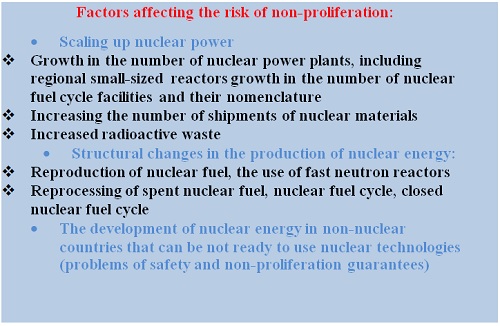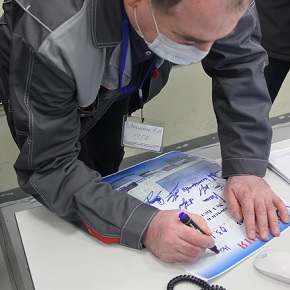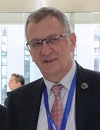 |
||
|
Global Analysis of Basic Problems of Full-Scale Nuclear Power Professor V.M.Murogov, This critical analysis of the history, state, and prospects of development of modern nuclear technologies shows that nuclear energy market has practically monopolized the design and construction of only one type of reactors (95% of NPPs under construction use pressurized water reactors), which necessitates training of focused specialists involved in the construction and operation of those nuclear power plants. One can say that the nuclear industry got engaged in premature "capitalization" of reactor science that was not properly developed, at a too "infant" age. We hurried to "force" nuclear power into the "locomotive" level of thermodynamics, working at the lowest parameters in modern power industry. As Academician Pyotr L. Kapitsa wrote in 1955, "it's impossible to create competitive new nuclear power units without changing the scientific and technical principle of converting nuclear energy into electric energy". Achieving a full-scale level of nuclear power, capable of solving social, economic and environmental challenges facing humanity, will require a fundamentally new concept for the development of nuclear power and the nuclear fuel cycle. No less serious task of our society is the formation of a new mentality for the mankind of the nuclear age. Nuclear energy will become an integral part of our culture and well-being, as electricity is now (Pyotr L. Kapitsa). 1. Introduction. Current state of global nuclear power. 1.1. Achievements. For over seventy-five years of reactor construction, nuclear power has become an industry comparable by its contribution to global electricity production (up to 10-15%) to hydroelectric power. Nuclear power is at the forefront of industrial development in thirty most developed nations. Under the auspices of the IAEA, many nuclear newcomers are planning the development and use of nuclear technologies and the construction of nuclear power plants. This is very important, taking into account the fact that a hundred of countries import more than 50% of energy resources, and forty countries do not possess own energy sources. Global nuclear power has reached a stable state: there are about 450 nuclear power units the world over with a total capacity of about 395 GWe; about 50 units are under construction. In most countries, nuclear science and technology make a decisive contribution to the further development of non-energy sectors of economy, in particular:
For example, the business volume in nuclear medicine in the United States is five to seven times higher than the volume of business in nuclear industry. At the same time, nuclear weapons possessed by the five great nuclear nations (USA, Russia, China, France, and Great Britain) being the basis of the UN Security Council, Non-Proliferation Treaty, IAEA along with other international organizations, maintaining world order, provide the basis for the international security regime. 1.2. Problems. As to the energy basis of modern civilization, it is still formed by organic fuel (oil, gas, and coal), whose share in the total energy balance is over 85% and up to 70% in electricity generation (the share of nuclear power is about 6% and 11%, respectively). In other words, it is too early to declare the fulfillment of the fundamental task of nuclear power (set by the nuclear industry pioneers and founders) - displacement of organic material as the base fuel of our civilization. A critical analysis of achievements and results of nuclear science & technology shows that the most successful development and application of nuclear technologies took place in the defense sector, where countries concentrated basic material, financial, and human resources. The principle of peaceful use of nuclear technology is implemented as the conversion of defense technologies (pioneer NPP in Obninsk, AM-1, Calder Hall NPP; starting from Shippingport NPP,with PWR reactors) - as a basis for the development of nuclear energy. The NFC technology is aimed at obtaining pure plutonium in limited amounts. Huge success has been achieved in large-scale centrifuge-based high enrichment of uranium-235. The development of reactor construction for nuclear power plants was determined by modern industrial production and by market requirements. In practice, it was reduced to the evolutionary improvement of nuclear power plants based on the successful "capitalization" of first-generation reactors. Reactor science has stopped in its development. The achievement basis was determined by particular technological issues (e.g., materials science, software systems, etc.). Breeder reactors that appeared more than seventy years ago still operate as pilot projects. As Academician P.Kapitsa wrote, reducing the achievements of nuclear technology to military purposes is similar to using the discovery of electricity just to invent an electric chair. Moreover, the hasty "capitalization" of nuclear technology at the initial stage of its development, when the energy potential was not used to the full in the pursuit of benefits, led to the "squeezing" of this fundamentally new energy source into the Procrustean bed of the "steam-water" thermal cycle. As a result, the current thermodynamic parameters of nuclear power plants remain at the level of the 1960s, and are the lowest in the energy sector (ηNPP ∼30%, ηCCP ∼60-65%). This leads to low parameters of power equipment and, as a result, to economic losses of the new unique technology (the paradoxical fact is that the plasma temperature in the nuclear fusion reaction reaches tens of millions of degrees while the operating temperature in the thermodynamic cycle is about 300°C). Conclusion: nuclear power and reactor science slowed down at the initial stage of being "pushed" into existing traditional thermodynamic methods of energy conversion. In other words, the development of nuclear power has stopped at an "infant" level. It is necessary to revive the creative spirit in reactor science and technology, and start training of specialists at a new, creative level - in contrast to the existing one. 2. Prospects and problems of nuclear power development in Russia (Rosatom). 2.1. Achievements. A total of thirty-eight power units of 30.3 GW installed capacity operate at eleven Russian nuclear power plants, including twenty-one power units with VVER reactors (three power units VVER-1200, thirteen power units with VVER-1000, and five power units with various modifications of VVER-440). State support for Russian nuclear industry has increased the share of nuclear power plants in electricity generation over the past decade from 16% to 19% (in Russia's European part, up to 40%), while the NPP share the world over in the same period has dropped from 16% to 10%, and in the overall energy balance, to about 5%. According to the press, Russia currently controls up to 50-60% of global nuclear energy market. At the same time, the underdeveloped machine-building base (fabrication of reactor vessels, turbines, etc.) requires the participation of foreign firms (on account of Russian loans for NPP construction). In compliance with the corresponding agreements and contracts, Rosatom is planning to build forty NPP units (thirty-two of them abroad), including more than twenty nuclear power plants in newcomer states such as Turkey, Bangladesh, Egypt, Nigeria, Uzbekistan, etc. In addition to providing materials, equipment, and funding for NPP construction projects (taking into account the capacities of local industry, banks, and personnel), foreign companies could participate in equipment supplies. Education and training of specialists at Russian universities and in nuclear organizations, as well as public education on the basis of information centers to be created, are also envisaged. Besides, Rosatom (TVEL) guarantees the supply of fuel to nuclear power plants, with spent fuel to be returned to Russia for storage and subsequent reprocessing. Thus, Russian nuclear industry is guaranteed a market for fuel fabrication, enrichment and reprocessing. At present, Russia controls up to 35% of fuel enrichment market and over 15% of fuel fabrication market (annual output up to 15,000 tons) producing about 5,000 tons of U3O8 and purchasing about 15,000 tons more abroad to provide fuel industry with necessary raw materials. This is how our achievements in the field of centrifuge enrichment is realized. At the same time, the fulfillment of these two economic tasks of the market nature ensures the fulfillment of the third task - political influence in the country (region) of NPP construction. 2.2. Problems. The export orientation of Russian nuclear industry to newcomers causes a kind of stagnation in the development of innovative technologies and in the national system of nuclear education. Over the past forty years, only one traditional type of pressurized water reactor VVER has been implemented on an industrial scale. Its modifications VVER-440, VVER-1000, VVER-2006, VVER-1200, VVER-1300 represent a single technological line (new concepts such as VPBR-640 or supercritical parameters have not been developed). Export orientation requires training of nuclear specialists from newcomer states for work at standard-type nuclear power plants, i.e. operators with the mandatory knowledge of instructions and control panel. The development of new technological solutions is excluded. Joint training with Russian students, specializing in reactor studies, determines the appropriate standard level of training of future operators of NPPs with the technology of the last century. The industry has no incentives to train the young generation of creative specialists capable of developing innovative reactor technologies. The situation is similar in most Old-World countries that gave birth to nuclear technologies. It is not by accident that almost all areas of the international GIF-4 project are an attempt to give life to experimental developments of the 1960s-1970s. Newcomer states are characterized by a low level of required knowledge and expertise. Donor countries should establish a system for collecting and transferring the necessary knowledge. At the same time, the industry focuses on internal personnel issues with the priority on the management of knowledge carriers (personnel) rather than on the knowledge itself. According to their thermodynamic parameters, present-day NPPs are at the level of hydrocarbon energy of the 1960s-1970s (30-35% efficiency). Modern energy sector develops on supercritical parameters with up to 60-65% efficiency (combined cycle). As a result, low thermodynamic parameters of nuclear power plants cause their low economic efficiency, even for newly built NPPs (USA). New developments of our competitors - primarily from China based on Westinghouse technology (CAP-1400), France (EPR), and South Korea - exceed domestic developments in economic parameters, threatening future losses in the nuclear energy market. 3. Internal contradictions preventing full-scale development of nuclear power. The full-scale development of nuclear power started with the conversion of defense nuclear technology, using for the purpose the design of nuclear reactors and nuclear power facilities, and NFC technology based on enrichment and reprocessing with the production of pure plutonium and highly enriched uranium-235. As a result, we failed to accumulate nuclear knowledge as a school of nuclear reactors, as we capitalized nuclear science in the pursuit of profit. This is one of the main reasons why nuclear power failed to solve its internal problems, turning potential advantages into disadvantages, unsolved problems that the "nuclear pioneers" initially put forward as advantages of the future full-scale nuclear power. 3.1. Resources as a basis for energy stability. The stocks of energy-grade uranium for PWR (BWR) are less than oil reserves, since this type of thermal reactors uses only about 0.5% of natural uranium stocks. The principal possibility of using almost unlimited resources of natural uranium and thorium based on secondary fissile isotopes of plutonium and uranium-233, obtained in nuclear reactors, has been known since the 1940s. To solve this problem, it is necessary to develop breeders operating in the closed nuclear fuel cycle (CNFC) with the production and recycling of secondary fissile isotopes.
3.2. Nuclear power facilities safety. Full-scale development of nuclear power on the basis of solving three problems listed above (stability, practical unlimited resources, breeders in a closed nuclear fuel cycle, non-proliferation of "sensitive" materials, technologies and knowledge) is possible only with guaranteed provision of nuclear and radiation safety of nuclear power plants and nuclear fuel cycle enterprises. The analysis of nuclear power development has shown the explicit dependence of the competitiveness of nuclear power on the realization of the above problems. As is known, at the initial stage of nuclear power development using the established defense "nuclear" platform (fuel and industrial infrastructure, education and training of personnel), the cost of installed capacity of NPPs with pressurized-water reactors was about 200 USD/kW. The current value is up to 4,000 USD/kW. What is the main reason for such a huge - 20 times - growth (except for inflation)? According to the NRC (USA), meeting the increasing requirements of "engineering" safety alone has led to an annual increase in the cost of generating electricity at nuclear power plants by 10-12%. Given the additional "penalty payments" for nuclear power that does not exist for traditional energy, the "market" (market economy) begins to get rid of this non-competitive technology. It is efficient from a market perspective. But in fact, the practical use of nuclear energy began as a major state task. And that is how it continues in the field of nuclear weapons. And the nuclear power was left to the mercy of the market. As a result, if the number of NPP units is less than 500, the acceptable risk of severe nuclear radiation accidents remains at the level of ∼10-5 (four circles of disasters: Mayak - Three Mile Island - Chernobyl - Fukushima).
3.3. Radioactive waste. At the initial stage of peaceful use of nuclear power, nuclear waste was considered to be an advantage of nuclear power because of its high concentration, limited volume (with the possibility of strict accounting, control and isolation) and gradual radioactive decay. But the presence of long-lived high-active fragments and actinides (primarily plutonium) requires a long-term controlled radioactive waste disposal for hundreds of thousands and millions of years which has no analogues in the history of mankind. Only Finland and Sweden have come up with a real solution for a controlled SNF storage facility without reprocessing. There is still no industrial solution to these problems (with or without recycling, forever or with the ability to control and access). As for the technology of long-lived high-active isotope transmutation, this process requires special fast reactors with a large excess of neutrons (so-called fast burner reactors), which so far exist only at a conceptual level. 3.4. Nuclear non-proliferation. If the aforementioned problems such as limited resources, the need to develop breeder reactors, development of the ÑNFC technology, management of radioactive waste, and provision of an acceptable level of nuclear & radiation safety for NPPs and the ÑNFC can, according to many experts, be solved sooner or later by providing necessary funding and inviting experts, there is no absolute guarantee for solving the problem of nuclear non-proliferation. It is known that the most "sensitive" technologies are the NFC technologies: enrichment and radiochemistry. The fact is that the reprocessing of SNF in a closed nuclear fuel cycle, in addition to the existing "sensitive" uranium enrichment technology, will lead to another "sensitive" technology: radiochemical processing, i.e., to extracting, from the "mountain" of irradiated fuel, of two materials potentially dangerous from the point of view of violation of the non-proliferation regime: plutonium and highly radioactive materials (fission products, actinides, etc.). That is, products potentially suitable for the creation of WMD or "dirty" bombs.  As was stated by the IAEA expert groups and at the NPT Conferences, a long-term principled solution of the nuclear proliferation problem is based on two essential factors:
4. Findings. As Academician Pyotr L. Kapitsa wrote in 1955, "it's impossible to create competitive new nuclear power units without changing the scientific and technical principle of converting nuclear energy into electric energy". Achieving a full-scale level of nuclear power, capable of solving social, economic and environmental challenges facing humanity, will require a fundamentally new concept for the development of nuclear power and the nuclear fuel cycle. No less serious task of our society is the formation of a new mentality for the mankind of the nuclear age. "Undoubtedly, scientific and technological successes, which were achieved in the nuclear energy utilization, mark a new era in the culture of humankind. The main significance of the technical use of atomic processes is that humankind has acquired a new powerful source of energy... What is happening now, when atomic energy is first of all regarded as a means of destroying people, is as petty and absurd as seeing the main value of electricity as a means for making an electric chair. Atomic energy for bombs would be as little used in the future as electricity for executions... The main importance of atomic energy lies in peaceful events, where it should revolutionize power industry and a number of leading branches of technology." (Academician P.L.Kapitsa. Excerpt from the article "Nuclear Energy" at the Journal "KOMMUNIST", 1955). Victor Murogov, Obninsk Topics: Victor Murogov, Opinions Other news: Akkuyu Nuclear JSC Obtains the Construction License of Akkuyu NPP Unit 3 The license application package was submitted to the Nuclear Regulatory Authority (NRA) on March 28, 2019. Rosatom starts production of rare-earth magnets for wind power generation The first sets of magnets have been manufactured and shipped to the customer. Unit No. 1 at the Belarusian Nuclear Power Plant has been brought to minimum control power Minimum control power level is reached when neutron flux is recorded in a reactor working at a level sufficient to sustain a fission chain reaction. |
Hero of the day 
Belarusian-1 has been connected to the grid The first kilowatt-hours of electric energy delivered by the Belarus NPP to the unified power grid system is a landmark to manifest the beginning of the nuclear age for the Republic of Belarus. INTERVIEW
Vladimir Kriventsev OPINION
Vyacheslav Kupriyanov, |

